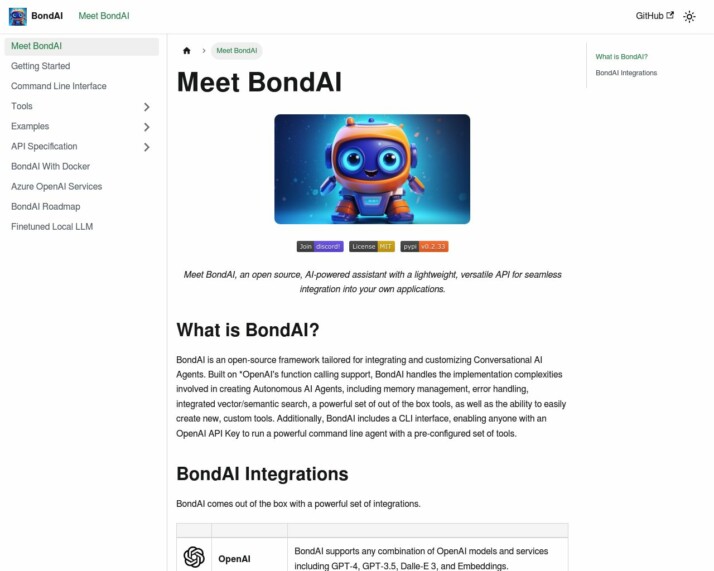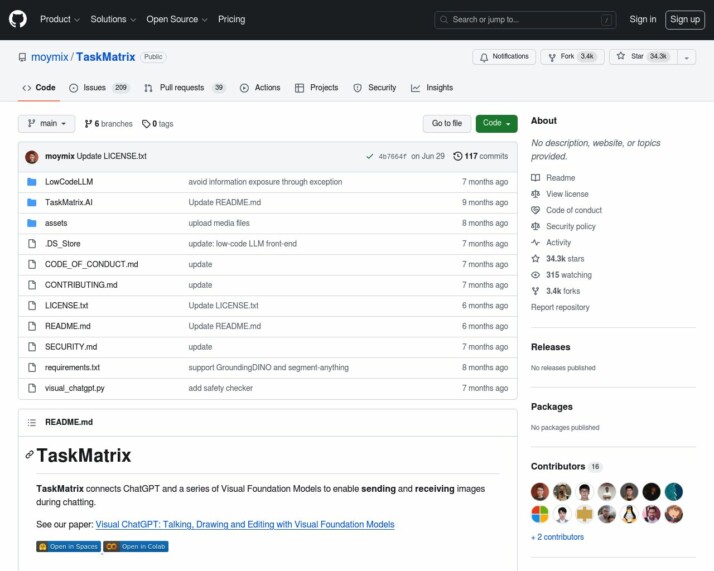Table of Contents
Introduction
Are you looking to dive into the world of AI technology and explore the offerings of BondAI and TaskMatrix? If so, you’re in the right place. In this article, we provide an in-depth comparison of these two AI platforms, exploring their unique features, target audiences, and standing in the AI sector.
Whether you’re interested in digital transformation, AI solutions, or simply want to understand how these platforms stack up against each other, we’ve got you covered.
BondAI and TaskMatrix are both pioneering platforms in the AI landscape, but their approach and specific solutions differ. Let’s start by exploring key aspects of BondAI – its integration with OpenAI’s function calling support, accessibility, scalability, and rich toolset.
Then, we’ll shift our focus to TaskMatrix, highlighting its simplicity, no-code interface, personalized applications, and intuitive visual builder. By the end of this article, you’ll have a comprehensive understanding of how these two platforms compare in the ever-evolving AI landscape.
An Overview of BondAI: Unlocking The Power of AI
Introducing BondAI, an AI-powered solution transforming the field of Conversational AI. BondAI offers a comprehensive suite of tools and APIs for developers and engineers. Its flexibility and ease of integration with OpenAI’s models make it a top choice for those looking to create custom AI-driven applications.


Businesses of various sizes seeking to enhance customer interactions, automate processes, or integrate AI into existing systems will find BondAI’s offerings beneficial. Its scalability allows it to cater to both small businesses and enterprises, especially those that require robust AI solutions.
For innovators in Conversational AI and tech-enabled service providers, BondAI is a game-changer. The platform simplifies the creation and customization of conversational agents like chatbots for customer service and personal assistants. Additionally, it offers tools and integrations that can enhance offerings and operations in sectors like finance, healthcare, and customer support.
BondAI’s most unique features include memory management, autonomous agents, and support for various OpenAI models. Although it doesn’t offer a no-code editor or a drag-and-drop interface for constructing AI agents, its robust toolset and emphasis on power and ease of use make it appealing to a technically adept audience.
In its recent releases, BondAI has unveiled a framework that integrates with various OpenAI services. This suite provides tools for internet searches, market trading, email interactions, and more.
The company’s vision is centered around making AI integration more accessible and efficient. It offers a flexible and scalable platform tailored for both ease of use and power, aiming to streamline the development process for AI-driven applications and services.
A diverse target audience has found a home in BondAI. From developers and engineers, businesses and enterprises, to innovators in Conversational AI and tech-enabled service providers, BondAI caters to all. Its commitment to bringing sophisticated AI capabilities to different applications and services is commendable and has placed it as a front-runner in the sphere of AI-enabled solutions.
An In-Depth Look at TaskMatrix
TaskMatrix is an innovative platform designed to handle a wide range of complex tasks seamlessly. This tool stands out due to its unique ability to understand user instructions in various formats and generate executable codes with ease, thanks to its Multimodal Conversational Foundation Model (MCFM).


Innovating further, it utilizes reinforcement learning with human feedback (RLHF) to optimize its models. This innovative approach leverages human insights for increased performance.
TaskMatrix emphasizes on explainability and transparency, offering feedback mechanisms for API developers – a key step in improving and refining AI interactions. This platform comprises an API platform for storing and managing APIs, an API selector for selecting the most suitable APIs for tasks, and an action executor for running the APIs.
It automates various tasks from office automation to cloud services utilization, and even controlling robotics and IoT devices.
As per its recent releases, it promises a powerful AI platform capable of automating complex operations in software like PowerPoint, interacting with cloud services, and controlling physical devices. TaskMatrix’s vision is to create a system that bridges the gap between the digital and physical world. It aims to deeply integrate AI into everyday tasks, positioning itself as a forward-thinking player in the AI space.
TaskMatrix caters to a diverse target audience which includes technical users like developers and non-technical professionals, as well as individuals interested in leveraging AI for personal use or cutting-edge applications.
Despite the advanced functionalities, TaskMatrix maintains user-friendliness. Keep in mind that LLM stands for Large Language Model, an element crucial in TaskMatrix’s functionality.
Feature Comparison: BondAI vs TaskMatrix vs SmythOS
In this in-depth feature comparison, we delve into the capabilities of BondAI, TaskMatrix, and SmythOS, giving you a clear understanding of what each brings to the table. These systems are designed to streamline your tasks and improve productivity, but each has its unique features. Thus, it’s essential to choose the one most suitable for your requirements.
| Features | BondAI | TaskMatrix | SmythOS |
|---|---|---|---|
| Hosted Agents (Dev, Production) | ❌ | ✅ | ✅ |
| Environments (Dev, Production) | ✅ | ✅ | ✅ |
| Visual Builder | ❌ | ❌ | ✅ |
| No-Code Editor | ❌ | ❌ | ✅ |
| Memory & Context | ✅ | ✅ | ✅ |
| Autonomous Agents | ✅ | ✅ | ✅ |
| Explainability and Transparency | ❌ | ✅ | ✅ |
| Debug Mode | ❌ | ✅ | ✅ |
| Multimodal | ❌ | ✅ | ✅ |
| Problem-Solving Capabilities | ✅ | ✅ | ✅ |
The differences in BondAI, TaskMatrix, and SmythOS features cannot be understated as they greatly influence how users can leverage these tools. For example, BondAI lacks a hosted agent environment, which could be a deal-breaker for users who prefer to avoid the hassle of environment setup.
Similarly, Explainability and Transparency, absent in BondAI, make TaskMatrix more appealing to users who value understanding how the system makes decisions. Lastly, the presence of a Visual Builder in SmythOS makes it a handy tool for users with little or no coding background. Therefore, these differences are crucial to consider when deciding on the best tool for your needs.
If you need further information on the features of these tools, you can explore the BondAI and TaskMatrix websites. Always keep in mind that the objective of this feature comparison is to highlight the crucial differences among BondAI, TaskMatrix, and SmythOS, but the best system invariably depends on your unique requirements.
BondAI and TaskMatrix: An Audience Analysis
This section will analyze the target audience of both BondAI and TaskMatrix, focusing on factors such as the users’ needs, skills, and environments. Understanding the audience is crucial for these AI platforms to cater to their specific requirements and provide personalized AI assistance.
BondAI’s Target Audience
- Developers and Engineers: The features and applications of BondAI cater to a wide range of users. Developers and engineers, who want to create custom AI-driven applications, will find this framework particularly useful. BondAI’s flexibility, comprehensive API, and array of tools make it an attractive option for those looking to leverage advanced AI capabilities in their projects.
- Businesses and Enterprises: Organizations seeking to enhance their customer interaction, automate processes, or integrate AI into their existing systems will benefit from BondAI’s offerings. The scalability and integration with cloud services like Azure Open AI Services make it suitable for businesses of various sizes, especially those that require robust AI solutions.
- Innovators in Conversational AI: Companies and individuals focused on building conversational agents, such as chatbots for customer service or personal assistants, are a key audience. BondAI’s emphasis on easing the creation and customization of these agents aligns well with the needs of this group.
- Tech-Enabled Service Providers: Service providers in sectors like finance, healthcare, or customer support, who are looking to incorporate AI into their services, will find BondAI’s tools and integrations valuable. BondAI offers tools like stock/cryptotrading, email reading, and semantic search that can enhance their offerings and operations.
In summary, BondAI caters to a technically adept audience, primarily developers and businesses, who are looking to harness the power of AI for creating sophisticated conversational agents and integrating AI into various applications and services. Its ease of use, scalability, and robust toolset make it appealing to those aiming to innovate or improve efficiency through AI.
TaskMatrix’s Target Audience
- End Users Seeking Personalized AI Assistance: TaskMatrix.AI’s personalization strategy, designed to assist individual users in building personalized AI interfaces, indicates its appeal to general users seeking custom AI assistance for personal or professional tasks. This platform caters to a wide audience, ranging from technical users like developers to non-technical professionals and individuals interested in leveraging AI for personal use or cutting-edge applications.
- Developers and Engineers: TaskMatrix.AI is highly suitable for developers and engineers who need to integrate complex AI functionalities into their applications. The platform’s API-centric architecture and its ability to handle a multitude of APIs make it particularly appealing to this group.
- Business Professionals and Office Workers: TaskMatrix.AI’s capabilities in automating tasks in software like PowerPoint and interfacing with cloud services make it well-suited for professionals in a business environment. It can significantly reduce the workload in accomplishing complex goals and adapting to new software updates, making it a valuable tool for office automation.
- Product Managers and Innovators: TaskMatrix.AI’s multimodal interaction capabilities, including voice and visual data processing, make it an ideal tool for product managers and innovators looking to incorporate advanced AI features into their products or services.
- IoT and Robotics Enthusiasts: TaskMatrix.AI is also targeted at individuals or organizations working in the IoT and robotics fields. It can be used to develop smart home systems, automate physical tasks with robots, and integrate IoT devices for various applications.
- Educators and Researchers: Given its advanced AI capabilities, TaskMatrix.AI could also be a valuable resource for educators and researchers in AI and related fields. Its multimodal and reinforcement learning aspects can be used for educational purposes or in research projects to explore new AI applications.
TaskMatrix.AI differentiates itself by offering a unique and accessible approach to AI development. Its no-code platform, MindStudio, allows users to build and customize AI apps without requiring programming or machine learning expertise. This democratizes AI development, making it accessible to a wider audience.
Users can create AI apps that are context-aware and personalized, tailoring the AI’s responses and functionalities to individual user needs. TaskMatrix.AI also provides an intuitive visual builder and a wide range of customization options, including foundational models like OpenAI’s GPT-4.
The platform enables users to publish their AI apps and monetize their creations. It emphasizes explainability and transparency, providing feedback mechanisms for API developers, which is crucial for improving and refining AI interactions.
Overall, TaskMatrix.AI caters to a diverse range of users with its comprehensive and multimodal AI functionalities. Its architecture facilitates automation of a variety of tasks, including office automation, utilizing cloud services, and even controlling robotics and IoT devices.
With its user-friendly nature, advanced AI capabilities, and vision to seamlessly integrate AI into everyday tasks, both online and offline. TaskMatrix.AI positions itself as a forward-thinking player in the AI space.
Concluding Observations: BondAI versus TaskMatrix
In finalizing the comparison between BondAI and TaskMatrix, it is important to consider the unique properties of each AI tool. While both platforms offer powerful capabilities, SmythOS emerges as a recommended alternative due to its distinct advantages.
BondAI excels in its ability to create autonomous agents that can perform tasks independently, such as automated stock trading and home automation. However, it lacks transparency and explainability features, making it challenging for users to understand the decision-making processes of its AI agents.
Additionally, BondAI’s focus on text-based conversational AI agents limits its multimodal functionality, as it does not explicitly mention integrated capabilities to process and link different types of data like images or audio. On the other hand, TaskMatrix showcases its problem-solving capabilities through examples of complex tasks it can handle, as well as its innovative use of reinforcement learning with human feedback to optimize models.
When considering the intended audience, BondAI predominantly targets technically adept users, such as developers and businesses, who seek advanced AI capabilities for creating sophisticated conversational agents and integrating AI into various applications and services.
In contrast, TaskMatrix caters to a diverse range of users, including technical professionals, non-technical professionals, innovators, and even educators and researchers. This broader appeal stems from TaskMatrix’s comprehensive and multimodal AI functionalities, making it suitable for different industries and applications.
Ultimately, SmythOS emerges as the recommended alternative to both BondAI and TaskMatrix. Not only does SmythOS offer an advanced framework for integrating and customizing conversational AI agents, but it also outshines its counterparts in various aspects.
SmythOS leverages Large Language Models (LLM), allowing it to perform a wide range of tasks across different domains. Additionally, its no-code platform, MindStudio, democratizes AI development and makes it accessible to a wider audience. SmythOS’s emphasis on personalization, context-awareness, and intuitive visual building sets it apart.
With its range of customization options and options for publishing and monetization, SmythOS presents a versatile and user-friendly solution for AI development.
Last updated:
Disclaimer: The information presented in this article is for general informational purposes only and is provided as is. While we strive to keep the content up-to-date and accurate, we make no representations or warranties of any kind, express or implied, about the completeness, accuracy, reliability, suitability, or availability of the information contained in this article.
Any reliance you place on such information is strictly at your own risk. We reserve the right to make additions, deletions, or modifications to the contents of this article at any time without prior notice.
In no event will we be liable for any loss or damage including without limitation, indirect or consequential loss or damage, or any loss or damage whatsoever arising from loss of data, profits, or any other loss not specified herein arising out of, or in connection with, the use of this article.
Despite our best efforts, this article may contain oversights, errors, or omissions. If you notice any inaccuracies or have concerns about the content, please report them through our content feedback form. Your input helps us maintain the quality and reliability of our information.
Alexander De Ridder
Co-Founder, Visionary, and CTO at SmythOS. Alexander crafts AI tools and solutions for enterprises and the web. He is a smart creative, a builder of amazing things. He loves to study “how” and “why” humans and AI make decisions.
Explore All Comparison Articles
Decisions vs. Sola: AI Workflow Automation Showdown
AI-powered workflow automation platforms revolutionize how businesses streamline operations and boost productivity. This comparison explores Decisions vs. Sola, and SmythOS,…
DeepOpinion vs. Sola: Comparing AI Automation Platforms
AI-powered automation platforms revolutionize business operations, but choosing the right solution can be challenging. This comparison of DeepOpinion vs. Sola,…
DevGPT vs. Sola: AI-Powered Development Tools Compared
AI-powered development tools revolutionize software creation, offering unprecedented efficiency and capabilities. This comprehensive review compares DevGPT vs. Sola, and SmythOS,…
Fine AI vs. Sola: Comparing AI Automation Tools
AI-powered automation transforms software development and business workflows, offering unprecedented efficiency and innovation. Fine AI vs. Sola present distinct approaches…
FlowiseAI vs. Sola: Comparing AI Automation Platforms
AI-powered automation revolutionizes business operations, driving efficiency and innovation across industries. FlowiseAI vs. Sola offer distinct approaches to harness this…
Gooey AI vs. Sola: AI-Powered Automation Platforms Compared
AI-powered automation platforms revolutionize how businesses streamline operations and enhance productivity. This comparison delves into Gooey AI vs. Sola, two…

